 | Back to e-WV
| Back to e-WV
 The West Virginia Encyclopedia
The West Virginia Encyclopedia
 | Back to e-WV
| Back to e-WV
 The West Virginia Encyclopedia
The West Virginia Encyclopedia
The community of Helvetia was settled by a small group of German-speaking Swiss immigrants in 1869. Other immigrants followed, and Helvetia evolved into a small, thriving community. Until the turn of the century when timbering began in the surrounding mountains, residents lived in relative isolation, maintaining their culture and native language. The 20th century brought great change, but Helvetia residents continued many of their traditions. Even today, visitors to the Randolph County community can participate in traditional celebrations, such as Fasnacht, which marks the end of winter and the beginning of Lent.
This exhibit is based on the work of David Sutton, who grew up in Helvetia. He is the author of the book Helvetia: The History of a Swiss Village in the Mountains of West Virginia published by West Virginia University Press. (The book is available at http://wvupressonline.com.) Sutton’s book contains numerous photographs, some taken by Walter Aegerter, who was born in Helvetia in 1894.
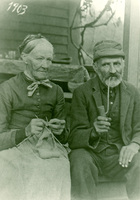
Katherine and Johannes Hofer Sr. sit on their porch in Helvetia in 1903. The Hofers immigrated from Grosshöchstetten, Canton Bern, in Switzerland in the early 1870s. Johannes Hofer was president of the Grütliverein, a mutual assistance society that helped members who needed help during planting or harvesting. The initial founding of Helvetia was carried out by a mutual aid society in Brooklyn. Photo by Gottlieb Hofer.
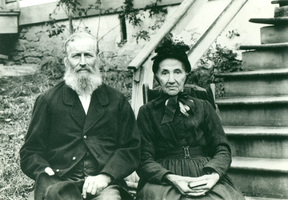
Originally from Boltigen, Canton Bern, Johannes and Anna Teuscher moved to Helvetia in 1872 from Ohio. In the 1880s, Johannes Teuscher and a partner built a small milk house at the Teuscher farm where surplus milk purchased from farmers was made into cheese. Photo by Aegerter.
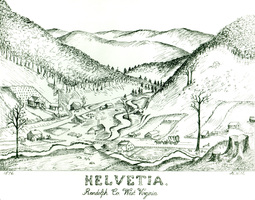
This drawing was probably done by settler Ulrich Müller in 1876 and is the earliest surviving image of the community. Müller, a stonemason, was one of the original six men who traveled from New York to Randolph County to inspect the land that was to become Helvetia.
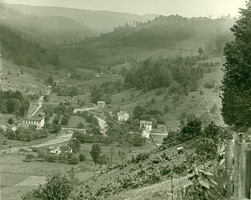
This photo of Helvetia in about 1910 shows the central village, which was occupied by skilled craftsmen. The town had about 20 different kinds of craftsmen, including carpenters, stonemasons, bakers, wagonmakers, and cheesemakers. The hillsides were cleared for farm use, while the cattle roamed free in the woods during the summer, a common practice in Switzerland. Photo by Aegerter.
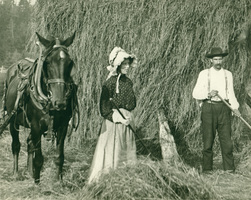
Women were expected to help in the fields, as indicated by this photo of Henrietta and Ernest Hofer haying in about 1905. Each family also had its own garden, which was tended primarily by the women and children. Photo by Gottlieb Hofer.
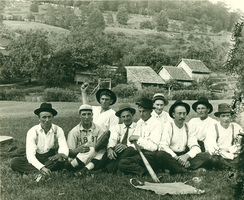
The Helvetia Baseball Team played in a cow pasture that had been measured off for a diamond. On Sundays, families and girlfriends gathered to watch the team play against teams from other towns. The railroad supplied a special train on Sundays to transport the baseball teams. Photo by Aegerter.
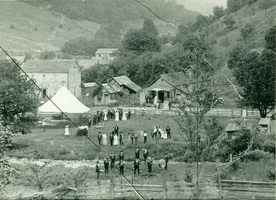
Residents are gathered for a community event in about 1910. The Star Band, in the foreground, provided music for many events, including the Fourth of July, Sunday School picnics, and the annual Community Fair. Photo by Aegerter.
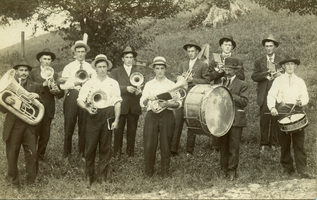
This photo shows the Helvetia Star Band, circa 1912. The band, organized in 1875, played both European and American march and dance tunes, as well as hymns and dirges for funerals. Photo by Aegerter.
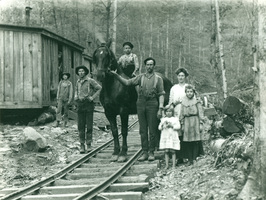
This photo from about 1910 shows a young family in a lumber camp. The arrival of the timber industry and the railroads that carried the timber changed life in Helvetia. Residents had access to paying jobs and a ready market for their timber. Families also began to grow extra produce for sale to the lumber camps and local hotels. Photo by Aegerter.
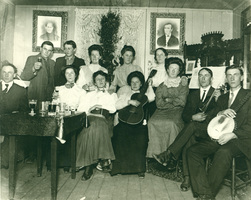
This photo shows a gathering at the Aegerter home. The Swiss and Germans maintained their tradition of brass music, but it was influenced by Appalachian fiddle and banjo music. Photo by Aegerter.
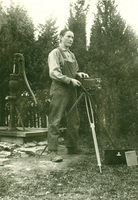
Walter Aegerter (July 8, 1894-May 28, 1965) was the youngest son of Gottfried and Marianna Dubach Aegerter, who immigrated from Switzerland to Helvetia in 1885. Walter made his living as a farmer but took up amateur photography as a young man, learning the craft from his father.
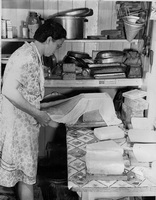
Cheesemaking has long been a tradition in Helvetia. Here, Emma Jo Betler makes cheese in her home in 1950. There is a Cheese Haus in Helvetia, but cheese is not sold there at the moment. There is not enough milk to supply it and no cheesemaker to produce it.
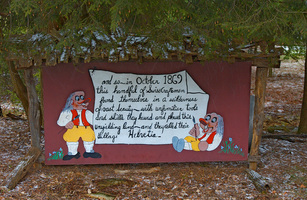
Visitors to Helvetia will see this sign: “And so in 1869 this handful of Swiss craftsmen found themselves in a wilderness of vast beauty – with unfamiliar tools and skills they hewed and plowed this unyielding land – and they called their village Helvetia.” The Randolph County town is on the National Register of Historic Places. Photo by Steve Shaluta.
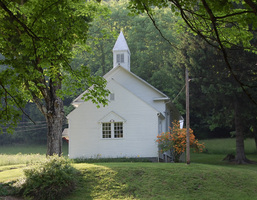
Helvetia residents dedicated the German Reformed Church on November 12, 1882. Services were held in German for many years, but during World War II it became impossible to find ministers who spoke both German and English. The Presbyterian Church began to provide pastors to the congregation, and in 1947, members voted to become part of the Presbyterian Church. The church remains a vital part of the community. Photo by David Sutton.
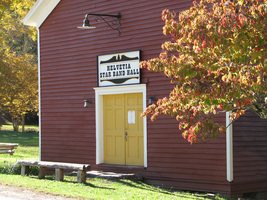
The Star Band Hall was built in 1901 and became the scene for social activities often attended by lumber and sawmill workers from other towns. The “outsiders” favored square dancing, over the kinds of dances—such as waltzes and polkas—preferred by the Helvetia residents. Eventually, a rule was established that governed the time allotted to square dancing.
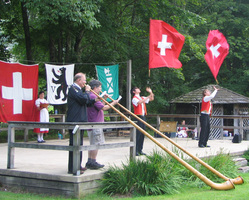
A community event features two Swiss traditions, the alp horns and the age-old art of flag throwing.